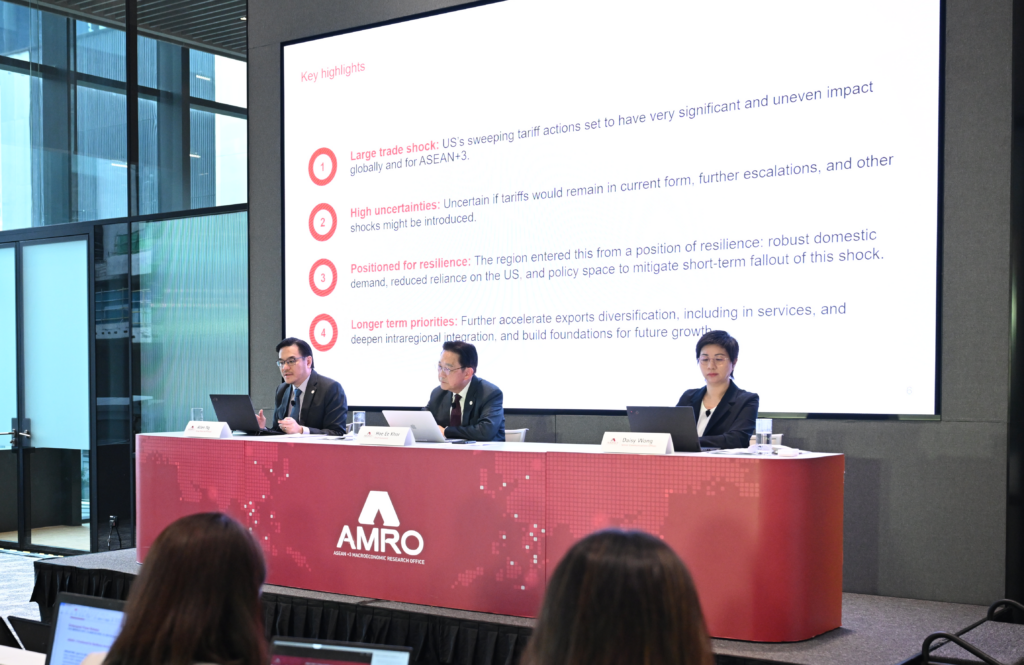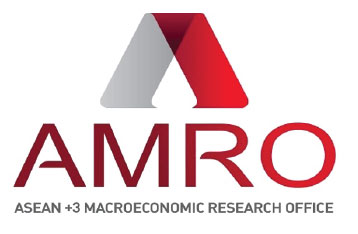
SINGAPORE, April 15, 2025 – The ASEAN+3 Macroeconomic Research Office (AMRO) today released its annual flagship report, the ASEAN+3 Regional Economic Outlook (AREO) 2025, highlighting the region’s resilience and policy capacity to withstand unprecedented global trade shocks following the US administration’s sweeping tariff announcement on April 2. These tariffs mark a sharp escalation in trade protectionism and have introduced heightened uncertainty far exceeding market expectations.
“The announcement of elevated and broad-based tariffs by the US, and the developments since, have added significant layers of complexity to the ASEAN+3 region’s outlook,” said AMRO Chief Economist Hoe Ee Khor. “Nevertheless, ASEAN+3 economies today are more resilient and diversified than during past global shocks and better positioned to navigate the unfolding tariff shock.”
The ASEAN+3 region faces a disproportionate impact from the US tariff measures. 13 out of the 14 member economies are subject to some of the highest effective tariff rates in the April 2 announcement, with a trade-weighted average estimated at 26 percent excluding China. These rates remain fluid and will likely evolve further in the coming months. These tariffs and the uncertainty generated by the constant shifts in policies are expected to weaken trade momentum, disrupt supply chains, and increase financial market volatility.
Still, the ASEAN+3 regional outlook is underpinned by resilient fundamentals. Prior to the announcement of the “Liberation Day” tariffs, AMRO had projected the region to grow above 4.0 percent in 2025 and 2026, supported by robust domestic demand, recovering investment, and low, stable inflation. However, the US tariff measures have introduced considerable uncertainty. Under the initial Liberation Day scenario, regional growth could slip below 4.0 percent in 2025 and weaken further to 3.4 percent in 2026. These preliminary projections are subject to significant uncertainties, as the US administration continually adjusts its tariff measures in response to market reactions and counter measures by trading partners.
While these trade shocks will weigh on ASEAN+3, the region is entering this period from a position of relative strength and resilience. ASEAN+3 economies possess ample policy space to cushion near-term shocks. Many governments have the fiscal capacity to deliver targeted support to vulnerable sectors and sustain domestic demand. Central banks in the region have room to ease monetary policy in view of the low and well-anchored inflation rates, and can deploy macroprudential tools and liquidity facilities to safeguard financial stability.
Over the years, regional economies have become more balanced, with domestic demand and intraregional trade emerging as key drivers of growth. Moreover, the region is now supported by a more diversified export market. The region’s share of exports to the US has declined steadily over the years. Exports to the US now make up just 15 percent of gross exports, compared to about 24 percent in 2000. Deepening intraregional trade and rapidly expanding domestic markets have reduced dependency on any single export market. Continued progress in regional integration and trade diversification will further strengthen the region’s ability to weather global turbulence.
As the region responds to these near-term risks, it should continue to aim at achieving development goals to revitalize its declining long-term growth and further build resilience to external shocks. Allen Ng, AMRO Group Head for Regional Surveillance, said: “Reinvigorating structural reforms and enhancing productivity are critical to unlocking the region’s untapped growth potential. Accelerating digitalization, embracing green transitions, and boosting productivity, can help ASEAN+3 sustain resilient, high-quality growth.” Key medium to long-term priorities include upgrading industrial capabilities, diversifying into renewable energy industries and markets, narrowing investment gaps, strengthening institutional capacity, increasing services productivity, and deepening integration in areas such as services and digital trade.
Despite today’s uncertain environment, the region has demonstrated its ability to endure and adapt. As Khor concluded: “ASEAN+3 has proven its remarkable resilience time and again in the face of global shocks. In this volatile trade landscape, unity and coordinated action will be essential. There are no winners in a trade war—but together, we can emerge stronger.”
The full AREO 2025 report is available on the AMRO website.
About AMRO
The ASEAN+3 Macroeconomic Research Office (AMRO) is an international organization established to contribute toward securing macroeconomic and financial resilience and stability of the ASEAN+3 region, comprising 10 members of the Association of Southeast Asian Nations (ASEAN) and China; Hong Kong, China; Japan; and Korea. AMRO’s mandate is to conduct macroeconomic surveillance, support regional financial arrangements, and provide technical assistance to the members. In addition, AMRO also serves as a regional knowledge hub and provides support to ASEAN+3 financial cooperation.
